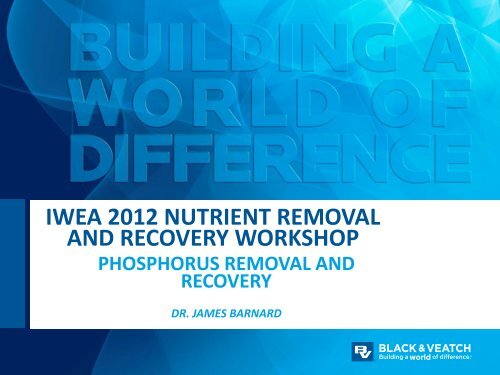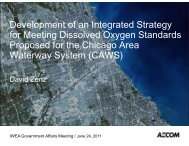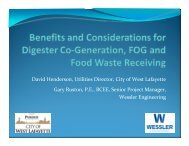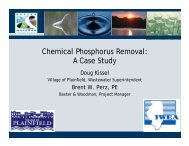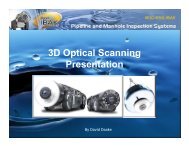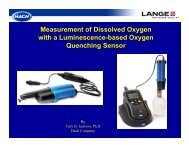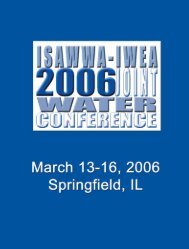anaerobic zone
anaerobic zone
anaerobic zone
Create successful ePaper yourself
Turn your PDF publications into a flip-book with our unique Google optimized e-Paper software.
IWEA 2012 NUTRIENT REMOVALAND RECOVERY WORKSHOPPHOSPHORUS REMOVAL ANDRECOVERYDR. JAMES BARNARD
PHOSPHORUS REMOVAL TECHNOLOGY10/8/2012DO & DON’TS AND FUTURE• Microbiology• Phosphorus AccumulatingOrganisms• Secondary Release• Glycogen AccumulatingOrganisms• Wastewater Characteristics• Volatile Fatty Acids• Recycle Streams• Typical Processes• Design Considerations• Fermenters• Operational Considerations• Nutrient Profiling• Full-Scale Examples• Phosphorus Recovery
B&V - ‹#›CHEMICALS, BIOLOGICAL ORBOTH?10/8/2012
Al/P (mol/mol)Al/P (mol/mol)DON’T THINK CHEMICALS EXCEPT FORPOLISHING EFFLUENT PHOSPHORUS2020181614Full Scale 6.6 - 6.75Lab data pH 6Lab data pH 7.2181614Full Scale 6.75 - 7Lab data pH 7.21212101088664422000.01 0.1 1 100.01 0.1 1 10ortho P res (mg/L)ortho P res (mg/L)Hermanowitz March 2006
COMBINED BIOLOGICAL AND CHEMICALPROCESSES• It is practically possible to reduce soluble phosphorus tolevels as low as 0.07 to 1.1 mg/L by biological means onlyin phosphorus removal plants• Further polishing with chemicals in tertiary treatment canreduce this to an effluent total P of less than 0.05 mg/L• Durham, OR used 175 mg/L of Alum when operatingchemical only, added to primary, aeration and posttreatment• Reduced to 25 mg/l when applying biological pluschemical polishing to get 0.07 mg/L as P• Pinery Water achieves LT 0.03 mg/L TP with abiological/chemical sequence10/8/2012
IS BIOLOGICAL PHOSPHORUS REMOVALRELIABLE?Biological phosphorusremoval is something youdesign for, hope for, thenadd chemicals if is doesn’twork- Paul Harremoes 1998Biological phosphorusremoval is notoriouslyunreliable- Paper at Beijing IWA 2008Conference
Concentration of P inmg/LRESULTS FROM EBPR OPERATION ATKALISPELL, MTKalispell MT Influent and Effluent PhosphorusInfl. PEffl.P65432101 2 3 4 5 6 7 8Years since 1993Effluent TPannual average0.11 mg/L in2003 withfiltration andno chemicalsBiological treatment plus sand filtration08/06/08
B&V - ‹#›MICROBIOLOGY10/8/2012
BIOLOGICAL PHOSPHORUS REMOVAL•A two-step process of phosphorus release anduptake under alternating <strong>anaerobic</strong> and aerobicconditions.• Phosphorus is released in the <strong>anaerobic</strong> <strong>zone</strong> to25 to 40 mg/L, taken up in the aeration basin toas low as 0.08 mg/L soluble P.WHY?10/8/2012
BIO-P ORGANISMS STORE PHA ANDRELEASE P IN THE ANAEROBIC ZONEInfluentRbCODInfluentFacultativeheterotrophsAcetic andpropionic acidPHAEnergyPoly-PPhosphateThese are obligateaerobes. They canstore but not processNo dissolvedoxygen or nitratesVFA from outside source10/8/2012
BIO-P ORGANISMS OXIDIZE PHA AND REMOVE PIN THE AEROBIC ZONEPoly-PPhosphatePHA stored in <strong>anaerobic</strong><strong>zone</strong>.Consumed in aeration basinproviding energy for storageof phosphorusEnergyPHAOxygen(Nitrate)Phosphorus taken upto
Poly-phosphate stored in the aerobic <strong>zone</strong>.Phosphorus is removed with the WASPoly-P10/8/2012
TOGETHERFuhs & Chen, 197510/8/2012
SECONDARY RELEASE SHOULD BE AVOIDED• Does not result in PHB formation• Phosphorus is not removed in aerobic <strong>zone</strong>10/8/2012
Secondary Release10/8/2012
SECONDARY RELEASE OF PHOSPHORUS• In Anaerobic basin when SCVFA is depleted – mixed liquorgoes truly <strong>anaerobic</strong>• In Anoxic <strong>zone</strong> when nitrates are depleted – mixed liquorgoes <strong>anaerobic</strong>• In 2nd Anoxic <strong>zone</strong> when nitrates are depleted• In final clarifiers when nitrates are depleted10/8/2012
GLYCOGEN ACCUMULATING ORGANISMS (GAO)COMPETES WITH PAOANAEROBICPhosphorusAEROBICGNPHVGlycogenPHVVFA10/8/2012
GLYCOGEN ACCUMULATINGORGANISMSGAOsGAOPossiblePAOs
GAO OUT-PERFORM PAO WHEN1. The temperature is high2. The SRT is too long3. The pH is low4. The unaerated <strong>zone</strong>s are too long5. Glucose is fed to the plant6. Acetic acid only is fed to the plant ??10/8/2012
B&V - ‹#›WASTEWATERCHARACTERISTICS10/8/2012
VSSISSSoluble ParticulateBOD = 0.58 * CODParticulateCOD p= 1.48 * VSSBOD, COD AND TSS ARE ALL RELATED….CODTSSFupBOD 5ColloidalFacFsdFbsX biod. particulate X unbiod. partRegisters as CODbut not BODFusFus - Non-biodegradable solubleFbs - Rapidly degradable soluble fractionFsd - Slowly degradable fractionFac - Fraction of Fbs that is SCVFAFxsd - Fraction of Fsd that is particulateFup - Non-biodegradable particulate fraction10/8/2012
SHORT-CHAIN VOLATILE FATTY ACIDS ARE ESSENTIALFOR BPR• Acetic Acid• Propionic Acid• How much and where do they come fromAcetic and propionic acids are the end products of acidfermentation under <strong>anaerobic</strong> conditions in sewers and reactorsRatios for ensuring Phosphorus RemovalCOD/P > 40RbCOD/P > 15VFA/P > 3 to 1610/8/2012
COD/P ratioESTIMATE OF VFA AND RBCODREQUIREMENTS FOR PHOSPHORUSREMOVAL25.020.0At this pointthere is noVFAVIPMcDowell CreekDurhamThese plants are gettingfantastic results15.010.0With FermenterEagle’s PointReedy CreekThis line is used inBNR models5.0w/o fermenterAt this point allrbCOD is VFA0.00 0.1 0.2 0.3 0.4 0.5 0.6 0.7 0.8 0.9 1Fraction of rbCOD that is VFA10/8/2012
VOLATILE FATTY ACIDS ARE FERMENTATION ENDPRODUCTS – BEFORE SLOWER GROWING METHANEPRODUCERS TAKE OVERAcidFormationPropionicAcid15% Complex65%Waste15%20%17% Acetic 35%AcidOtherIntermediatesMethaneFormation13%72%Methane15%If we can stop theprocess here we getVFA10/8/2012
VOLATILE FATTY ACIDS CAN COME FROMSEVERAL SOURCES• Collection system fermentation• Slow flowing sewers – slime and debris• Longs pumping mains – slime in pipes• Primary clarifier sludge blanket• On-site fermenting of primary sludge• Fermenting of the rbCOD in <strong>anaerobic</strong> <strong>zone</strong>s• Supplemental VFA’s – added or fermented on site• Fermentation of a portion of the MLSS10/8/2012
HOW DO I DETERMINE THE RBCODFRACTION• This is done by respirometry to see how much oxygen uptakeoccurred rapidly• However there is a substitute test that is easy to performcalled the flocculated and filtered COD to establish the purelysoluble biodegradable COD fraction. (WERF study 99-WWF-3• Flocculate the feed with chemicals and filter. Do the same with the effluent from a long SRTactivated sludge plant or bench scale unit. The remaining soluble COD will mostly be unbiodegradable.Subtract this from the feed fraction to get the truly soluble biodegradablefraction in the feed, which is a good measure of the rbCOD fraction.10/8/2012
DETERMINATION OF rbCOD (Fbs)10/8/2012CODinFupParticulateColloidalFacFusFsdFbsFus - Non-biodegradable solubleFbs - Rapidly degradable soluble fractionFsd - Slowly degradable fractionCOD removed by Flocculation and FiltrationCOD removed by Flocculation and FiltrationCODoutParticulateFusFac - Fraction of Fbs that is SCVFAFxsd - Fraction of Fsd that is particulateFup - Non-biodegradable particulate fractionZn(SO4)Influent or primaryeffluentFlocculation andFiltered COD Test
B&V - ‹#›TYPICAL PROCESSESCONFIGURATIONS10/8/2012
CONFIGURATIONSThe plant may be designed for• Phosphorus removal only - HiRate Phoredox (AO) – must beoperated not to nitrify• Phosphorus and Total Nitrogen reduction - Bardenpho• Phosphorus and Ammonia removal – 3-stage Phoredox (A20)– UCT, VIP, MUCT, JHB etc10/8/2012
HIGH RATE PHOREDOX (AO)FeedMixerAnaerobicAerated SectionSettling TankRecycled BiomassWasteBiomassNo nitrates in RAS10/8/2012
FOR PHOSPHORUS AND NITROGENREMOVAL TO LOW CONCENTRATIONSLow nitratesin RAS10/8/2012
AMMONIA AND PHOSPHORUSREMOVALRAS is denitrified beforepassing to the <strong>anaerobic</strong><strong>zone</strong>AnaerobicAnoxicAerobicJohannesburg (JHB) ProcessModified JHB Process10/8/2012
WESTBANK PROCESS – TAKE ALL PRE-CAUTIONSFermenterInfluentEffluentWestbank ProcessAnoxic Anaerobic AerobicRAS is denitrified by endogenous respiration plus some feed.VFA is added to the <strong>anaerobic</strong> <strong>zone</strong>. Storm flows to the anoxic <strong>zone</strong>10/8/2012
B&V - 41VFA PRODUCTION BYFERMENTING PRIMARYSLUDGE08/06/08
EXAMPLES OF ACID FERMENTATION OFPRIMARY SLUDGE• Activated PrimaryVFAAccumulate sludge inprimaries and fermentto digestersAnaerobic <strong>zone</strong>• Complete-mixfermenterHold sludge for 6 to8 daysPrimary tankVFA<strong>anaerobic</strong> <strong>zone</strong>to digesters08/06/08
TWO-STAGE FERMENTER AND THICKENERYou can add elutriation waterPrimaryTankAnoxicVFAAnaerobic <strong>zone</strong>FermenterThickenerTo digester08/06/08
STATIC FERMENTERPrimary tankVFAto digesters<strong>anaerobic</strong>AnoxicVFA to <strong>anaerobic</strong> <strong>zone</strong>Oversized Thickener – retainsludge for 6 to 8 daysGrimstadNorwayWestbank BC08/06/08
B&V - 45OPERATIONAL CONSIDERATIONS08/06/08
TO PROTECT PAO• Reduce the SRT to the minimum, especially when thetemperature is high• Do not over-design the plant unaerated <strong>zone</strong>s• Add alkalinity when the pH drops below 7• Feed a combination of Propionic and Acetic Acid to theplant• Add molasses to fermenter – it ferments rapidly to aceticand propionic acid10/8/2012
DON’T BLOCK THE SCUMThis is badThis is goodThis is worseThis is horrific !!!!10/8/2012
GETTING RID OF SCUMScum FormationAnoxic ZoneAerobic ZoneScum EntrainedAnoxicZoneAerobic Zone10/8/2012
WILSON CREEK, TXDon’t fall into the scum trap10/8/2012
VOLUMETRIC SRT CONTROL &SELECTIVE WASTAGE• Mixed liquor and scumwasted to satelliteclarifier• Can be wasted to DAF unit• Accurate controlof the SRT• No scum to thefinal clarifiersSRT = V.X/dV/X= V/dV daysAucklandNZ
ANAEROBIC ZONE• Zero dissolved oxygen• Zero nitrate• Presence of volatile fatty acidsTo FCRASPEAerationMixed liquor recycleAN AN AX AX AX08/06/08
OPTIMIZING ANAEROBIC ZONE PERFORMANCE• Eliminate Nitrates or oxygen in feed or RAS• Avoid aeration of primary effluent – back up launders• Reduce RAS rate - low but not so low as to releasephosphorus• Detention time as short as possible – 30 to 45 minutes withenough VFA in feed• Install pre-anoxic <strong>zone</strong> for RAS denitrification• Use minimum mixing energy (2 W/m 3 ) {0.08 hp/kcf)}• Supply external source of volatile fatty acids – if required• Pre-mix influent streams and direct to the bottom08/06/08
ANOXIC ZONE• Denitrification – avoid recycling dissolved oxygen• Keep mixing energy to minimum (as for <strong>anaerobic</strong> <strong>zone</strong>• Some BioP organisms use nitrates• Carbon used for BioP may not be available for denitrificationTo FCRASPEAerationMixed liquor recycleAN AN AX AX AX08/06/08
MIXERS - DO AND DON’TB&V - 55
OPTIMIZING ANOXIC ZONE• Avoid aeration• Mixing energy low (2.5 to 3.0 W/m 3or 0.09 to 0.11 hp/kcf) when usingslow speed vertical entry mixers• Use mixing chimneys for rapid mixof influent stream then direct tobottom• Sufficient MLR to reduce nitrates inAX <strong>zone</strong> effluent to aeration basinto 1 mg/l• Avoid secondary release - with lowMLR rate <strong>anaerobic</strong> conditions mayresult.
CHIMNEYS FOR MIXING – AVOIDSHORT-CIRCUITING95% of flow streams mix welland pass through bottom. Scumcan overflow at peak flow10/8/2012
BAD EXAMPLE OF MIXED LIQUOR RECYCLEToo much aeration
GOOD DO REQUIRED FOR PHOSPHORUSUPTAKE IN AEROBIC ZONE• Run DO high at top end and low at bottom end ofaeration <strong>zone</strong>.• In channel systems phosphorus removal can becontrolled by effluent phosphorus monitoring. If theaeration is insufficient effluent phosphorus goes up.• Problem with mixing energy required at end of aeration<strong>zone</strong> resulting in high DO being recycled to the anoxic<strong>zone</strong>. Ignore or install mixers - this is addressed inNitrogen removal10/8/2012
AEROBIC ZONE• Sufficient SRT fornitrification – no more• Adequate dissolvedoxygen for rapid uptake• Lower DO near mixedliquor recycle pumps• Baffle recycle pumps tominimize fine bubbleentrainment• Neutral or higher pHTo FCRASPEAerationMixed liquor recycleAN AN AX AX AX08/06/08
B&V - 63NUTRIENT PROFILING08/06/08
PrimaryAnaerobAnoxic 1Anoxic 2Anoxic 3Aerobic 1Aerobic 2Aerobic 3Phosphorusmg/LWESTBANK WWTPPrimary Anaerob Anoxic 1 Anoxic 2 Anoxic 3 Aerobic 1 Aerobic 2 Aerobic 35.36 20.56 2.20 1.84 1.60 0.50 0.20 0.0310.009.008.007.006.005.004.003.002.001.000.00Bioreactor ProfilePhosphorus by ZoneNote P uptake in Anoxic Zone
B&V - 65FERMENTATION OF MIXED LIQUOR FORPHOSPHORUS REMOVAL08/06/08
ALTERNATIVE APPROACHES100 m 3 pilot plant (1972)Barnard, J.L. (1985), The role of full scale research in biological phosphate removal. Proceedings of the University ofBritish Columbia Conference on New Directions and Research in Waste Treatment and Residuals Management,Vancouver, Canada, June 23-28.66
STROUD ET ALSOUTH CARY NC – WEFTEC 2001Note that all influent carbon is available for denitrification.Stroud et al achieved average TN
PINERY WATER COKEVIN CLARKESWITCHED OFF MIXERPhosphorus reduced from 9 mg/Lto less than 0.5 mg/L , then withpost chemical treatment to lessthan 0.03 mg/L. Overall molarratio to Al:P is 0.568
BPR OPERATION AT ST CLOUD MNUNDER-AERATION69
1/1/024/11/027/20/0210/28/022/5/035/16/038/24/0312/2/033/11/046/19/049/27/041/5/054/15/057/24/0511/1/052/9/065/20/068/28/0612/6/063/16/076/24/0710/2/071/10/084/19/087/28/0811/5/081/1/024/11/027/20/0210/28/022/5/035/16/038/24/0312/2/033/11/046/19/049/27/041/5/054/15/057/24/0511/1/052/9/065/20/068/28/0612/6/063/16/076/24/0710/2/071/10/084/19/087/28/0811/5/08Effluent Total P (mg/L)Effluent Total P (mg/L)14121086420BIO-P THROUGH OPERATIONS14121086420St. Cloud, MN(turning the air down in the first pass)From Tracy HodelTotal P 30-day Moving Avg (Total P)Total P 30-day Moving Avg (Total P)70
CAROUSEL PLANT HENDERSON NV60 ML/D – UPGRADED TO BNR71
SURFACE APPEARANCE OF HENDERSON PLANTSome hours after mixer offDuring mixing72
Phosphorus (mg/L)RESULTS FROM HENDERSON NVOrtho-P for May 20100.5ANA Eft SPS SCC Final Eft0.40.30.20.105/1/20105/2/2010Final Clarifier Effluent5/3/20105/4/20105/5/20105/6/20105/7/20105/8/20105/9/20105/10/20105/11/20105/12/20105/13/20105/14/20105/15/20105/16/20105/17/20105/18/20105/19/20105/20/20105/21/20105/22/20105/23/20105/24/20105/25/20105/26/20105/27/20105/28/20105/29/20105/30/201073
IOWA HILL CO PLANT—LAY-OUT OF BIOREACTOR10% of flowUnused74
PUMPING BACK FROM SIDE-STREAMFERMENTER75
Effluent Ortho P mg/LPHOSPHORUS REMOVAL WITHSIDE-STREAM FERMENTATIONIOWA HILL CO PLANT – From Chris Maher0.30.259/8/2011 9/9/2011 9/10/20110.20.150.10.05076
B&V - 77PHOSPHORUS RECOVERY08/06/08
ANAEROBIC DIGESTION OF WASTEACTIVATED SLUDGE• 60% to 80% of phosphorus remains in the sludge• Remainder may need chemical removal before recyclingChemical dose much less than in main stream• Chemicals could be settled in the primaries• McDowell remove phosphorus biologically and digest – 7mgdplant Alum cost $400/month• Could be more in other places10/8/2012
PHOSPHORUS IN RETURN STREAMS• In greenfield plants, look for options that will not releasephosphorus.• Some Struvite precipitation takes place in the digesters –Can remove up to 80% of the phosphorus in the WAS -could cause problems• After digestion and lagooning there is little phosphorus inthe supernatant.• Returning the centrate to the primary tanks and treatingit with Alum cost about $400/month for McDowell,Charlotte NC10/8/2012
RECYCLE STREAMS INCREASE THEPHOSPHORUS LOAD• Primary thickener overflow• Belt filter press filtrate• Centrate• Facultative sludge lagoon supernatant• Anaerobic digester supernatant10/8/2012
THE NUTRIENT MERRY-GO-ROUNDNitrogen Gases, CO 2InfluentN,PMainstream Biological Nutrient RemovalTreatedEffluentN,PPrimary Solids(some nutrients)WAS(nutrient-rich)ImportedBiosolids =ImportedN, PThickeningSidestream(somenutrients)ThickenedBiosolidsBiosolidsProcessingAnaerobic DigesterNH 3 -N,PO 4 -PReleasedDewateringSidestream(nutrient-rich)CakeN,P10/8/2012
PHOSPHORUS IS A LIMITED RESOURCE AND ISIRREPLACEABLE• US produces 25% of world resources• Morocco has 6 times the deposits of the US• Production limited to a few countries• In less than 50 years high grade ore will run out• At the present rate of consumption we may have enoughfor another 200 years• The USA has stopped exporting phosphorus• We cannot afford to use it once and waste it08/06/08
Phosphorus is a limitedresource23,000,000From D Vacarri “The looming phosphorus crisis” Scientific American Inc June 2009
NORTH AMERICAStruviteAlso recovers upto 20% of nitrogenMg.NH 4 .PO 4.6 H 2 OPlants in OperationmgdEdmonton AB 80Durham OR 20Suffolk VA 20York PA 20Rock Creek OR 30Madison WI, Slough UK,Saskatoon SK underconstruction
MULTIFORM - HARVESTBoise ID 40 mgdCorvallis OR 11 mgdCity of Yakama WA 15 mgdDairy wastes – 300 cowHog farmsPotato processinghttp://www.multiformharvest.com/index.php
Paques Plant - Rijn & IJsel – Olburgen STW
STRUVITE TO FERTILIZER PLANT
LIME TREATED RAW BIOSOLIDS WITHAMMONIA CAPTUREHigh pH drives off ammonia whichis captured as ammonia nitrate
INCINERATOR ASHDeposit indedicatedsite forfuturerecoveryFactory at Vlissingen Neth. Use8000 tonnes of incinerator ashas phosphorus rock substituteScope No 74 Oct. 2009
URINE RECOVERY• Urine contains 70 to 80 of theNitrogen and Phosphorus indomestic wastewater• When urine is separated andstored ammonia is hydrolyzed andthe pH goes up• Within a few weeks the urine istotally free or pathogens• Research underway to recoverstruvite• Excess ammonia recovered withstripping and production ofammonia sulphate
BACKYARD GARDEN – KAMPALAUGANDA
DO-IT-YOURSELF FERTILIZER
www.bv.com


